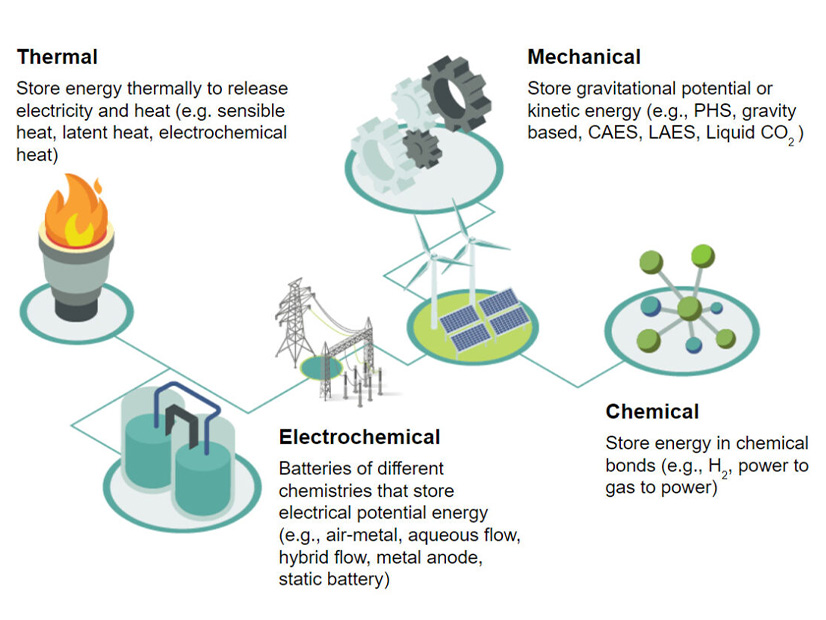
Long-duration energy storage (LDES) will play an essential role in cost-effectively decarbonizing California’s electricity grid, according to a report released by the state’s Energy Commission (CEC) Jan. 29.
The study, prepared by researchers from Energy+Environmental Economics (E3), Form Energy and University of California, San Diego, explores how LDES can help California meet goals set out in Senate Bill 100, the 2018 law requiring the state to serve all retail electricity load with emissions-free power by 2045.
Relying on modeling of the CAISO grid, it represents the most in-depth analysis to date of the crucial role the technology will play in California’s transition to renewable energy.
The report also examines LDES’s ability to reduce air pollution in the Los Angeles Basin, as well as its role in supporting resilience in microgrids.
Main Findings
The study found that California has made significant progress in its energy transition, with prior studies showing the electric sector could reach 80% or greater decarbonization with existing technologies. But achieving decarbonization and reliability won’t be cheap without innovations in LDES, which could be a viable replacement for the natural gas-fired power plants that are traditionally relied upon for dispatchable capacity to balance renewables and meet grid reliability standards.
Under a business-as-usual SB 100 scenario, which allows for retainment of all existing gas resources, the study found that deploying 5 GW of LDES could cost-effectively bring CO2 emissions down to 12 million metric tons by 2045. LDES is far more cost-effective with up to 37 GW deployed by 2045 under a zero-emissions scenario that covers in-state emissions and electricity imports.
Simulations across 35 historic weather years in the Los Angeles Basin case study showed that LDES enables retirement of gas plants in the CAISO system while maintaining reliable grid operation. By 2045, 21 GW of LDES could substitute for all of California’s existing gas plant capacity. Without LDES, the study found that the cost of using other resources to avoid reliance on gas plants increases by up to 87%.
“Portfolios that retire in-state gas by using LDES were found to achieve cost parity, and in some cases cost savings, relative to those that retain existing in-state gas,” the study found.
While researchers highlighted that further analysis is needed to evaluate the environmental justice benefits of retiring gas-fueled generation more quickly, they demonstrated that LDES will likely play an important role in cost-effectively maintaining local capacity requirements while reducing the need to rely on emitting resources in disadvantaged communities.
“In Form’s study of the Los Angeles Basin as an example area, 2 GW of LDES and 1.3 GW of 4-hour lithium-ion storage is found to be the least-cost substitute for gas power plants located in disadvantaged communities, lowering system costs by 3%,” Form Energy said in a brief about the report. “This is the first time that the benefits of LDES to local reliability and environmental justice have been studied in the state, creating a model for how other local reliability areas can be studied in the future.”
Support for Microgrids
In a case study of microgrids at the University of California, San Diego, the team also found that LDES can support high-reliability microgrids by pairing with other distributed energy resources to deliver 48-hour resilience capability, also known as “islanding,” and protecting against outages.
However, LDES-supported microgrids may not be cost-effective. The study found that the customer value of lost load needed to justify its use ranged between $5-18 kWh for small campus buildings. Some larger buildings, though, demonstrated a negative value of lost load, showing that some microgrids improve reliability while reducing costs.
Goals
In addition to demonstrating the distinct value LDES will bring to California’s energy transition, the study highlighted the need for modeling tools and approaches that can continue to accurately capture the value of LDES in future portfolio planning. It also emphasized the importance of optimizing resource needs with hourly time resolution across a full year and in varying weather scenarios.
“By using these methodologies, grid planners can proactively identify resources that electric markets may not yet be fully valuing,” Form’s brief said. “From there, policy initiatives can be designed to ensure these resources are able to rapidly proliferate and deliver savings to the electric grid.”

